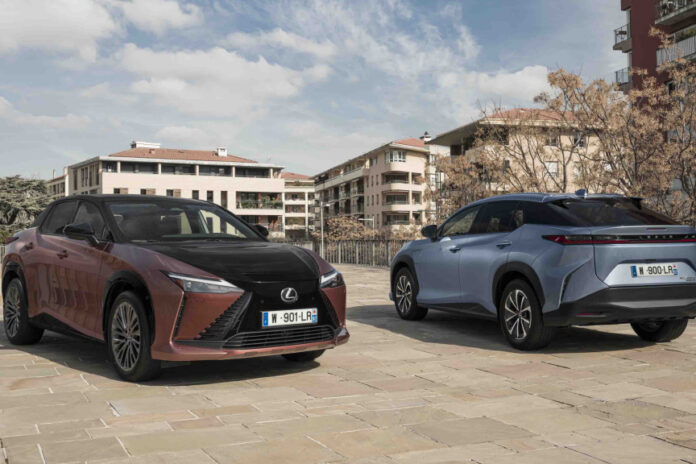(Aix-en-Provence, France) Lexus’ first electric climber, the RZ450e demonstrates that it’s more than a gentrified Toyota bZ4X.
Lexus will pave the way for the complete electrification of the Toyota group, assures its new president. The RZ450e therefore becomes the mascot of a firm that has pledged to stop shipping combustion engines to European, North American and Chinese markets by 2030. But until then, Lexus has a lot to do. to keep up with the competition.
Next month Toyota will have a new President and CEO, Koji Sato. The latter will succeed Akio Toyoda who, during his tenure, hammered more than once that the turn to “watture” was being negotiated too quickly. For him, this forced transition does not take into account in particular those countries which produce their electricity with fossil fuels. Even less of consumers’ ability to pay because of the tariffs charged. Koji Sato’s speech is more nuanced. He believes that “now is the time” for the world’s leading automaker to unbox its offering of 100% electric vehicles.
After Toyota (bZ4X), the turn of its luxury subsidiary to introduce its first battery-powered model: the RZ450e. The latter, which begins a commercial career in a few weeks in Quebec and British Columbia (the other provinces will have access to it later), is available in three versions: Signature, Luxury and Executive. None of them qualify for a government grant. Unlike a number of its competitors, Martin Gilbert, brand manager in Canada, has no intention of slashing comfort or safety features. “For our part, we intend to remain faithful to our DNA and our positioning in the market,” said Mr. Gilbert. According to him, the tolerance for high prices, imposed by batteries, would be greater among consumers of luxury vehicles.
Built on the same architecture as Toyota’s bZ4X, this Lexus has several notable distinctions. First, the RZ450e adopts a four-wheel drive mode as standard. In a second, the power of its electric motors (there is one on each axle) produces 50% more power than those responsible for moving the Toyota. The net battery capacity, however, remains the same (71 kWh). Finally, its increased exterior dimensions (length and width) mainly favor the cargo volume which, on this Lexus, compares favorably to that of its rivals.
The front seats are comfortable. Those in the back too, except beware of the arch of the roof (the Lexus is lower than the Toyota) when getting in or out of the back seat.
The element that strikes the most before even getting behind the wheel of this Lexus is the significant impact of the tires on performance. Fitted with 20″ rubber, the Luxury or Executive trim levels result in higher energy consumption. Therefore, and considering how often autonomy is THE differentiating factor between electric vehicles, the entry-level model (Signature) appears to be the greenest choice if not the most luxurious.
At its controls, this Lexus drives smoothly, without the slightest vibration. The front axle shows a slight laziness when it is requested. Properly weighted power steering helps cornering with confidence, but doesn’t make the ride any more fun. The fun will no doubt be in the electronic steering dubbed “One Motion Grip”. The latter has no mechanical link between the steering wheel and the wheels. The benefits are many (see our sidebar in the “Datasheet” tab), but for now, this technology still needs some tweaking before it gets the green light. According to Lexus officials present at the world premiere, this groundbreaking steering is expected to make its market debut within two years.
Despite the overweight imposed by its batteries, the softness of Lexus is preserved and the RZ450e appears rather light to drive. And responsive too thanks to its two thrusters capable of producing the equivalent of 313 hp. Without sticking to the seat, acceleration is instantaneous, overtaking maneuvers are vigorous. For its part, the energy recovery device – configurable using paddles on the steering wheel – does not allow you to do without the brake pedal. The latter, however, is dosed without difficulty.
Lexus, the neo-converted to electromobility, must still improve in terms of consumption and efficiency, because those of the RZ450e are currently towed by its competitors. Under these conditions, the approximately 300 km announced seem particularly optimistic, especially in winter.
From $64,950 to $80,950
No (provincial and federal)
Now, but you have to place the order
19.6 kWh/100 km (tyre 18 po)/ 22.4 kWh/100 km (tyre 20 po)
Pleasant and comfortable ride Surprising agility Rear seat clearance
Impossible to tow anything Disappointing range Impossible to drive with one pedal
We had to start somewhere
Lexus announces the upcoming commercialization (within two years) of a direction having no mechanical connection. This is not a revolution in itself as Infiniti has been offering such a device for some time now on its Q50 sedan. But there is an important difference. For safety reasons, the Infiniti doubles its system to a conventional (read mechanical) system. In the event of a breakdown, Lexus relies in particular on a battery and an additional computer. These two components turn out to be much lighter and also allow the steering column to be completely eliminated.
According to Lexus, the RZ450e takes approximately 9.5 hours to charge on a level 2 station. On a fast station, the partial refueling (80%) of the battery is completed in 30 minutes. To calm owners’ anxiety, the RZ450e relies on a specially designed driving setting to maximize range by, for example, limiting speed (100 km/h maximum) and suspending certain accessories such as the air conditioner.
La Presse will soon publish the test of the following vehicles: BMW 2 Series, GMC Canyon, Nissan Ariya, Subaru Crosstrek and Toyota Corolla Cross Hybrid. If you own one of these vehicles or are waiting for delivery, we would love to hear from you.















